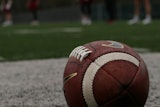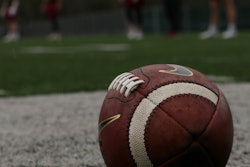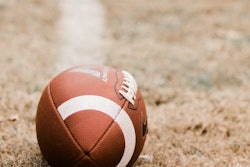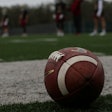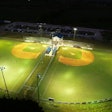In pursuit of athletic competition, humankind has harnessed the best that nature has to offer. The argument could be made that in many ways we've managed to improve upon nature. Indeed, we have successfully recreated nature in order to satisfy our desire to play what we want wherever we want - all the while respecting the integrity of the game and the well-being of its participants.
This is no more evident than in the surfaces on which sporting events are staged, from the natural (grass fields and hardwood courts) to the not so natural (synthetic turf fields and mechanically refrigerated ice sheets). But as they make every effort to produce an environment most conducive to fair and safe competition, are those individuals responsible for the production and upkeep of these surfaces serving as stewards of the environment at large? You make the call.
NATURAL GRASS
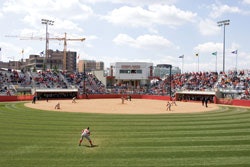 Photo of a natural grass baseball field
Photo of a natural grass baseball field
The product of soil, seed, sun and water, no medium has more organic origins or a longer history of accommodating physical activity than grass. It has been our sports surface of choice for centuries.
But when a lot of sports, or even the same sport, is accommodated again and again on the same field of play with little recovery time in between, or when flawless appearance and elite-level playability are at a premium, grass requires more maintenance than just about any other surface, too. And in the opinion of one environmentalist, the turfgrass profession that has emerged over the past half-century is rooted more in industry than academia. "I think what we ended up developing was a system based on products rather than knowledge," says Kevin Trotta, New York team captain of the Global Sports Alliance, an international nonprofit organization focused on sports and the environment. "That in itself is not a sustainable system. I think the 21st century brings the need for a new paradigm when it comes to the management of turfgrass."
Research has found that cutting back on the amount of petroleum-based fertilizers doesn't significantly reduce the quality of turf, particularly in well-established turfgrass areas where soil conditions have benefited from years of natural root growth and decay cycles. Trotta, who oversees 60 acres of multipurpose athletic fields for the North Rockland Central School District, says the concept of perfect turf has come to be defined by corporations, not end users, and that today's Little Leaguers should be able to live with a dandelion or two on their infield. He promotes situation-specific turf maintenance over a one-size-fits-all, more-is-better approach, adding that it's all too easy to give grass plants too much nitrogen, phosphorus and potassium. "At that point, it's no longer fertilizer," he says. "It starts to become pollution."
Gas-powered turf-care equipment is another pollution source, posing a dilemma for turf-care specialists who know turf thrives the more often it is cut. And the greater the frequency of cut, the finer the clippings, which when left on the field can significantly decrease fertilization demand. "All the macro- and micronutrients that turf is composed of are contained in those clippings," Trotta says. "It's the ultimate recycling."
For their part, power equipment manufacturers are producing far more fuel-efficient machines than were marketed 15 years ago, and emissions have been reduced in some instances by up to 75 percent. Likewise, agronomists are constantly working to preserve another natural resource - water - by introducing drought-resistant turf species to sports turf applications, as well as cultural practices that promote deeper, more-efficient root development. Soil-moisture sensors are now available to take the guesswork out of irrigation strategies and help avoid unnecessary applications of water. Natural organic fertilizers made from composted poultry waste and feather meal have emerged as alternatives (albeit more expensive ones) to controlled-release synthetic organics.
Environmental turf craft is, in Trotta's words, a compelling responsibility, and today's well-educated turf-care provider must constantly weigh risks and rewards. "Wanting to produce for the user the best we can possibly give them is a noble thing," he says. "But it's irresponsible to try to deliver that without also thinking about the ultimate costs - economic and ecological."
SYNTHETIC TURF
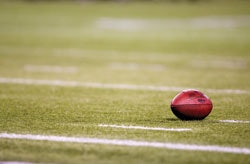 Photo of a synthetic turf football field
Photo of a synthetic turf football field
From its inception, synthetic turf has been sold as a low-maintenance substitute for natural grass. As the product, in its current infill iteration, has come to look and feel more like grass, manufacturers have not only seized significant market share, they've gained some fairly substantial traction in the green movement, too.
Consider that, in the estimation of a leading manufacturer, one regulation-size synthetic turf football field requires a million fewer gallons of water over the course of a year than a comparable grass field. (End users may water synthetic turf fields as needed to clean them or cool them down.) That same field will not see the application of thousands of pounds of pesticides and fertilizers. And since the field never requires regular mowing or aerating, it will prevent between four and five tons of carbon emissions from reaching the atmosphere on an annual basis.
That said, the industry came under intense scrutiny last year following the discovery of inordinate amounts of lead in dust from specific types of synthetic surfaces. In July, the U.S. Consumer Product Safety Commission determined that lead levels were insufficient to pose a public health risk. But that didn't stop the state of California from suing three manufacturers in an attempt to force them to find alternatives to lead as a means of stabilizing color in their products.
To date, manufacturers have demonstrated a willingness to make several aspects of the turf manufacturing process more green. Soybean oil derivatives and other biological compounds have emerged as an alternative to petroleum in the production of turf systems, and post-consumer content such as plastic beverage bottles is also being incorporated. Yarns designed to reflect solar energy off the playing surface are now available, while recycled rubber has long served as turf's preferred infill material, with one regulation-size football field steering roughly 20,000 car tires away from landfills.
After eight or so years of heavy use, field components facing replacement are often earmarked for secondary applications, too. Polyethylene turf fibers are being recycled into everything from backpacks to garbage bags. Geotextile backing can be used in general landscaping or under road surfaces as a drainage barrier. Sand and rubber infill can be separated, cleaned and reinstalled in new turf systems. And more uses are being explored. "Our industry is still relatively young when it comes to recycling fields," says a representative of the aforementioned manufacturer. "That side of the industry is just starting to grow, but we're working on a pretty aggressive recycling program."
SYNTHETIC TRACKS
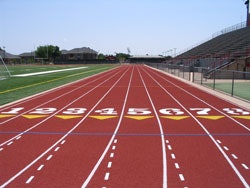 Photo of synthetic track
Photo of synthetic track
Track surfaces entered the fast lane of environmental friendliness within the past two years, as the first water-based structural spray formulation was introduced as an alternative to the decades-old solvent-based variety. These urethane topcoats contain few if any volatile organic compounds, dry quickly (expediting multicoat applications) and clean up with water (as opposed to chemicals). Their heavier consistency means less overspray, and excess material can be disposed of as non-hazardous waste. In addition, the textured surfaces succeed in resisting UV damage while maintaining tensile strength and resiliency over a paved underlayment of recycled rubber and polyurethane.
"One of the advantages of polyurethane tracks is you don't need to rip up and remove the track," says one major manufacturer's representative. "These tracks can all be resurfaced, extending the life of the facility for a fraction of the original capital expenditure."
Tracks currently in development will feature all organic and biodegradable components, such as cashew oils and soy-based polyols (the base of polyurethane). While more expensive than traditional tracks, such systems can prove critical to facilities seeking LEED certification. Unfortunately, as the green track movement hits its stride, potential end users - high schools, mostly - find themselves hamstrung by tightening budgets. "It's a double-edged sword, because the technology that goes into creating an environmentally friendly track surface that utilizes these additional bio-based and natural components has a little bit of additional cost to it," says the track manufacturer's rep. "As the processes used to create the raw materials become more refined, and as demand increases, the price point will lower."
HARDWOOD COURTS
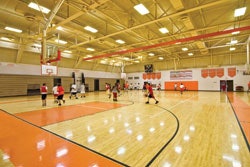 Photo of a hardwood gynasium floor
Photo of a hardwood gynasium floor
Hardwood gymnasium floors have been in existence as long as there have been gymnasiums, and for good reason. They provide a forgiving, long-lasting and aesthetically pleasing surface for a variety of indoor ball sports and fitness activities. Hardwood is so durable, in fact, that a well-maintained court made from maple, birch or beech is likely to outlive the gym it's in.
Now, in the midst of an international green movement, hardwood's reputation has been further burnished. Thanks to managed harvesting, and the fact that a hardwood species' shade-tolerant nature allows it to regenerate all by itself, there is more standing timber in the United States currently than there was in the late 1800s. That includes more than 200 million acres of certified sustainable forestland, where five tons of carbon per acre is sequestered each year in hard maple stands owned by commercial mills. Even growers that aren't certified by the likes of the Forest Stewardship Council (an international organization requiring chain-of-custody documentation) are more likely than not to practice sustainability. Their very future in business depends on it. Says one certified grower, "We're pulling carbon out of the atmosphere, storing it in trees for 100 years and then taking that tree before it starts deteriorating and putting it into a product that lasts 40 to 50 years. That's two generations."
This, he adds, is what ultimately separates hardwood from bamboo, which gained buzz as a sustainable gym floor alternative beginning in the 1990s. Bamboo's selling point is that it is a fast-growing, easily replenished resource. Good bamboo - several layers of which are adhered to one another - can result in a finished product that's even harder than maple, according to one bamboo flooring distributor, and off-gassing of chemical additives such as formaldehyde is an issue that has largely been addressed. The aforementioned hardwood flooring manufacturer representative counters that hard maple stores more carbon than bamboo and requires less fossil-fuel emissions in its transport (bamboo is typically imported from China). While the U.S. Green Building Council awards up to two LEED points for bamboo installation, it awards up to four times as many for 34-inch northern hard maple, particularly if it is harvested within 500 miles of the job site. (Additional LEED points can be obtained by applying low-VOC finishes to the surface.) And while the certification of northern hardwood products is just now catching up to decades-old forestry practices, there remains little Chinese government oversight of bamboo production. "We were so far ahead of the curve," says the hardwood flooring rep. "We've been practicing sustainable forestry for 100 years."
ICE SHEETS
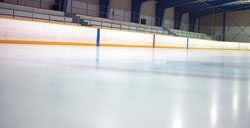 Photo of an ice rink
Photo of an ice rink
Demanding an average 1.2 million kilowatt hours of power per ice sheet per year, ice rinks are recognized as the greatest consumers of electricity among all public venues in any given community.
But great strides have been made within the past 20 years in terms of rink efficiency. Because the ice-making process centers on the removal of heat from a concrete substrate, waste heat that was once exhausted from rinks has been put to more productive use. It can be used to heat water, which is then returned to the rink every time the ice is resurfaced. It can heat the building's lobby and dressing rooms, defrost the rink floor and dry the saturated silica in desiccant dehumidification systems. The latter use is particularly efficient, given that dehumidification demand increases in warm weather, precisely when the ice plant is working hardest and waste heat isn't needed to heat the building.
Waste heat also has been used to melt the snow scraped off the ice during resurfacing, but some refrigeration experts consider that strategy counterproductive, given the energy reuse potential of the snow itself. Ice water extracted from a rink's snowmelt pit can be sent through a heat exchanger to cool the liquid refrigerant line coming off the rink's condenser. By the time the liquid brine reaches the chiller, where compressors extract heat from it before it is sent on a 10-mile circuit through the rink floor, the brine has already dropped 30 degrees in temperature, greatly easing the chiller's mechanical burden.
Rinks that are operated during summer months or located in warm climates have been known to direct their snow to outdoor collection tanks, where it is melted by the ambient air temperature and used for landscape irrigation. Rinks in cold-weather regions, meanwhile, have embraced the use of fluid cooling, in which ambient air exchanges with heat extracted from the refrigerant brine in large exterior radiators, sufficiently cooling the floor-bound brine without running the chiller's 150- to 200-horsepower compressors at all. (Petroleum-based synthetic ice has emerged as a refrigeration-free alternative, but more so in outdoor recreational skating environments.)
Exterior air - particularly the warm, moist variety - can vex rink operators and tax their refrigeration systems if too much is allowed to infiltrate the building envelope. In that sense, the use of electric ice resurfacing machines may become a more attractive alternative to those that run on fossil fuels - based not on comparative energy savings of the machines themselves (batteries, while much improved over the years in terms of reliability, still need to be recharged), but rather on the elimination of the need to introduce fresh outside air into the rink to rid it of toxic carbon emissions.
Naturally, greater rink efficiency makes economic and environmental sense. A representative of one leading refrigeration company compares alternative energy costs to rink efficiency savings, placing the average price of one kilowatt produced by wind at $5,000 and one produced by solar power at between $7,500 and $10,000. Meanwhile, one kilowatt can be saved for a mere $1,000 investment in improved rink efficiency. "With wind and solar, you are producing power only when there is wind or sun," he adds. "With energy savings measures, you are saving power whenever the refrigeration system is running, which could be as much as 20 hours a day in warm weather."
Even the most efficient rinks will produce more heat than they can use, though, and some have taken to sharing it. On a small scale, this might entail siting a rink (a net producer of heat energy) next to a pool (a net consumer of heat energy). Within the past five years, several communities in North America have developed district energy loops, connecting ice rinks and other heat-producing commercial venues to a feeder pipe from which residences and other commercial venues can extract heat. "At that point, the ice rink doesn't become an environmental liability," says the refrigeration industry representative. "It actually becomes an environmental asset."














